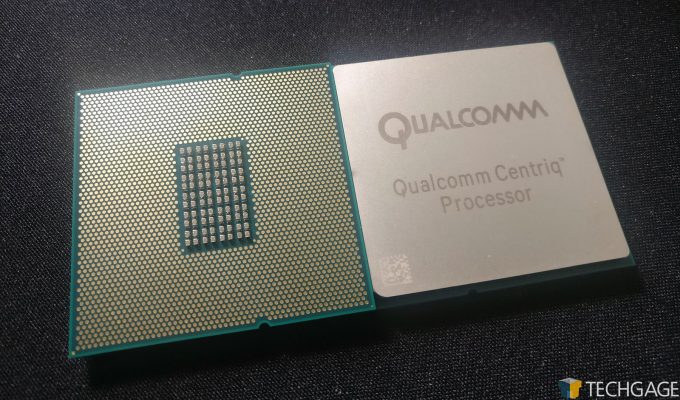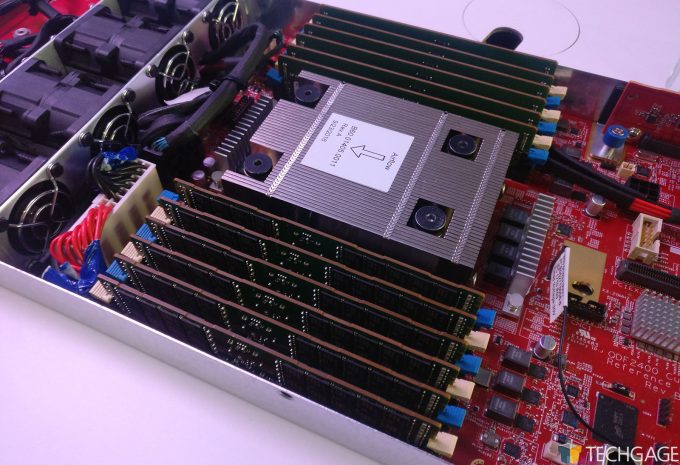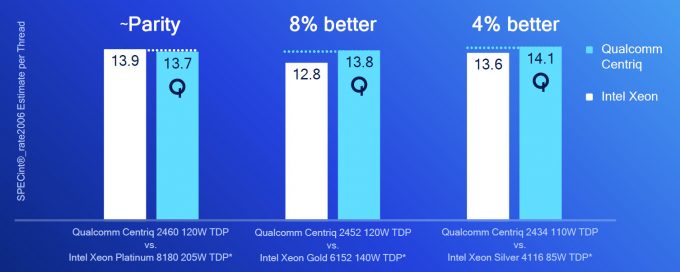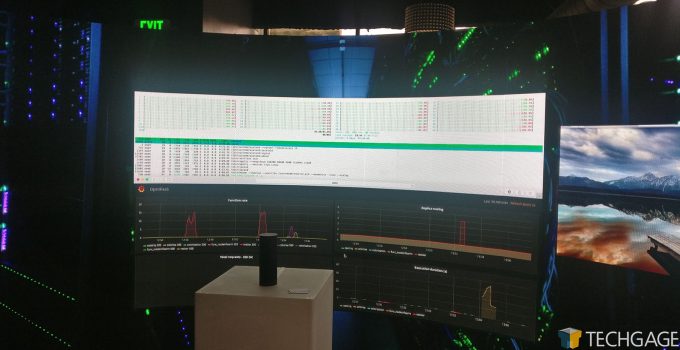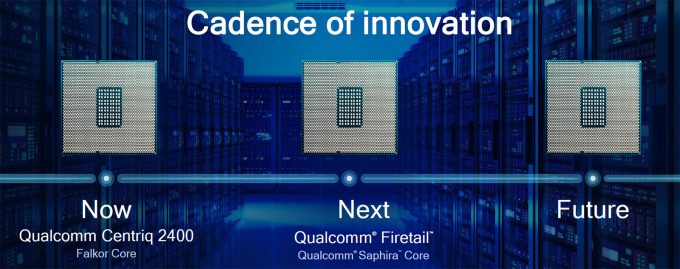- Qualcomm Launches Snapdragon 4 Gen 2 Mobile Platform
- AMD Launches Ryzen PRO 7000 Series Mobile & Desktop Platform
- Intel Launches Sleek Single-Slot Arc Pro A60 Workstation Graphics Card
- NVIDIA Announces Latest Ada Lovelace Additions: GeForce RTX 4060 Ti & RTX 4060
- Maxon Redshift With AMD Radeon GPU Rendering Support Now Available
Qualcomm Launches Centriq 2400 Series: CPUs Laser Focused On The Datacenter

After spending five years in development, Qualcomm has unveiled its Centriq 2400 server processor line, with chips built around ARM and ready to take on the biggest workloads. Qualcomm is laser-focused on the datacenter, and based on what we know now, it has huge potential to pave the way for a healthy share of the market.
It seems universally agreed upon at this point that 2017 has become one of the coolest years in history for CPU releases. There were so many twists and turns, as well, making it hard to keep track of everything.
The fun really kicked-off this past spring when AMD launched its hugely anticipated desktop-bound Ryzen processors, which to our surprise proved to be very competitive against Intel. That “very competitive” further became heightened this past summer when the company released Threadripper for enthusiasts, and EPYC for the enterprise.
As for Intel itself, it struck back at AMD by releasing its Core X series, also in the summer. That was capped off with the release of a top-end 18-core processor this fall, a move that represents Intel beating its chest and growling at AMD, refusing to bow to the newfound pressure.
And then we have Qualcomm. If AMD stabbed Intel with its slew of Zen launches this year, Qualcomm has engraved “Centriq” on the knife and given it a loving twist. In case it isn’t obvious, that’s pronounced “Sen-trick”, not “Sen-treek”.
When Qualcomm first told me about Centriq a couple of years ago, I really wasn’t sure what to expect, although the promise that Intel’s Xeons were in the company’s sights made the intrigue leading up to the launch quite strong.
The result is Centriq 2400, a series with many core CPUs up to 48 cores, with a 1:1 core/thread ratio, as there is no multi-threading implementation built-in (at least yet). Not that 48 cores is anything to balk at – this is Qualcomm’s first serious server chip, and it’s a lot more feature-packed than I originally believed it would be. Qualcomm isn’t just going after Xeon low-end… it’s even going after the top-end Platinum SKUs in some cases. The company even bundles all of its IO on chip, rather than use the two-chip solution Intel has on its platforms for quite some time. Qualcomm is trying really hard to impress out-of-the-gate.
Think about this: Qualcomm is the world leader for mobile-bound SoCs, and now, it’s jumping into a very different market with one heck of a product. I didn’t expect things to ramp up so fast, but here we are, and according to Qualcomm, Centriq is selling to customers right now – not just for testing, but for deployment.
A Look At Qualcomm’s Centriq 2400
With the Centriq 2400 series, Qualcomm is building on the expertise that’s propelled it to become the biggest seller of mobile SoCs in the world. You might even say that “Snapdragon” has become a household name in the tech world, because finding an Android phone that’s mid-range or higher without a Snapdragon chip underneath is rare (much to Intel’s chagrin).
While these first Centriq server CPUs are Qualcomm’s first, they’re far from unrefined. The 10nm cores (a first for server CPUs) under the hood are the company’s fifth-gen, based on the company’s Falkor design, which was tailor-made for the datacenter. Qualcomm has many goals with Centriq 2400, but overall, they encompass the usual targets: low-power, high-performance, and of course, features.
These new chips are ARMv8 compliant, and support the AArch64 architecture, both of which are unsurprising. Due to its ARM nature, Centriq isn’t going to immediately cater to everyone, but those already working with ARM will be set, and those willing to port should be able to vastly improve their parallel computing capabilities with this chip for attractive ROI. The chip also supports ARM’s TrustZone for booting and firmware (EL3), and also for virtual machines (EL2). Further, AES, SHA1, and SHA2-256 instructions are on tap, as well.
| Cores | CPU Speed | L3 Cache | TDP | Price | ||
| Centriq 2460 | 48 | 2.2 GHz / 2.6 GHz | 60 MB | 120W | $1,995 | |
| Centriq 2452 | 46 | 2.2 GHz / 2.6 GHz | 57.5 MB | 120W | $1,373 | |
| Centriq 2434 | 40 | 2.3 GHz / 2.5 GHz | 50 MB | 110W | $888 | |
| Et cetera | All Centriq 2400 series CPUs support 6x DDR4 channels (DDR4-2667) at 128GB/s, and up to 768 GB in capacity with RDIMM or LRDIMM. They also include support for 32 PCIe lanes up to x16 in speed, as well as 8 SATA 6Gbps ports. More information can be found here. | |||||
Equipped with all of these cores, Qualcomm’s biggest target out-of-the-gate with Centriq are cloud servers (storage, FaaS, et cetera). At a press event held in San Francisco last week, the company talked about battling Intel’s biggest, baddest Xeons in a handful of respected benchmarks. So while the $1,999 SKU on top of the Centriq stack might fall well under Intel’s $10,009 Xeon Platinum 8180, Qualcomm isn’t ashamed to call that chip its most appropriate competition.
In performance slides, Qualcomm showed its Centriq 2400 chips to beat out the much more expensive Intel competition. With SPECint_rate2006, Qualcomm either matched or beat Intel’s competition (the models Qualcomm chose, at least), and watt do you know, Centriq is even more power-efficient overall.
At its press event, Qualcomm had a slew of vendors on hand to talk about what makes Centriq so irresistible to them, with one of them being Packet, whose booth can be seen in the shot below. This company specializes in enabling customers to use bare metal servers, getting as close to the hardware as possible, which then allows them to use them for FaaS purposes.
In the photo above, a listening Amazon Alexa device interprets what you say, and then passes along the message to the remote server. Whenever a simple command was issued in this testing, one of the Centriq’s 2460 cores would spike ever-so-slightly. Then, a more serious workload was invoked, involving a black and white TV show being automatically colorized. Not surprisingly, this peaked all 48 cores without much delay.
Other companies on hand covered the spectrum of servers and uses, such as video image processing, deep-learning, SAN, and bioinformatics. Red Hat, Canonical, and SUSE were all present, touting their support for Qualcomm’s ambitious chip. CentOS also officially supports Centriq, though the company wasn’t represented at this particular event.
One of the biggest concerns many will have about a platform like Qualcomm’s Centriq is probably obvious: it might require a move from x86 to ARM. Qualcomm realizes this very well, but it’d like to remind people that the ARM ecosystem is already very rich, and supports a wide-range of popular applications. Those include Java, OpenJDK, PHP, Python, Azul, Node, and Golang for languages. For virtualization, it supports KVM, Xen, and Docker. Databases? MongoDB, NGINX, Apache Spark, and more. It also supports the super popular memcached caching solution.
Speaking of software support, Cloudflare’s CEO Matthew Prince helped sell the product based on experiences of testing with it inside of one of the biggest internet companies going. Prince said that moving his company’s software to ARM was easier than expected (though we don’t know the extent of what had to be ported), but in doing so, the company found it could double the requests per watt with a chip like those in Qualcomm’s Centriq line.
Techgage‘s server is built around Ubuntu, NGINX, and PHP, and happens to use Cloudflare as its main caching solution, so many things said at last week’s press event resonated with me. I am sure that I am missing something that would allow me to “easily” move the site over to an ARM-based platform, and it could be that most project managers will run into the same kind of roadblock. But that’s one to be expected… moving from one platform to another isn’t necessarily meant to be effortless.
Whatever effort is required, Qualcomm is confident that its new chips could help make the transition well worth it, definitely when it comes to the performance delivered per watt. That focus, and the fact that Qualcomm is giving people at least 40 cores per Centriq 2400 to do work with, means that the company is pretty anxious to begin doing battle with Intel, among others.
Given what it offers, $1,999 for the top-dog Centriq 2460 sounds like a good bargain, and if so, then it means the 40-core 2434 at $888 could be considered a steal. With that particular chip, Qualcomm targets Intel’s $1,000 Xeon Silver 4116, a chip with 24 threads. I don’t have experience with Intel’s latest Xeons, so I can’t easily quantify that kind of comparison, but there is something to be said about the 40-core Centriq offering twice as much L3 cache per thread than Intel does on the Silver 4116, and not to mention more threads in general.
At this point in time, we’re at the mercy of what Qualcomm and its initial customers tell us, but as the products are shipping right now, it shouldn’t take too long before we start to see more activity around Centriq in the industry. ARM-based servers have always filled a certain role, but Qualcomm dramatically expands that role with the Centriq 2400 series, making it a truly viable solution for servers that manage a ton of data or jump on the same project with as many cores as possible.
The future is going to be interesting. So interesting, that Qualcomm is already talking about what’s next. Well, at least by name: Qualcomm Firetail will be the next-gen Centriq, and it will be built around the Saphira core.
And that could annoy Intel to its very core.
Qualcomm is so confident in its mobile chips, that one of its current slogans is, “We’re the reason you love your smartphone.” That’s a very bold statement, but it’s hard to argue considering how many Snapdragon devices are out there. Will the company soon be able to say the same thing about servers? Time will tell.
Support our efforts! With ad revenue at an all-time low for written websites, we're relying more than ever on reader support to help us continue putting so much effort into this type of content. You can support us by becoming a Patron, or by using our Amazon shopping affiliate links listed through our articles. Thanks for your support!




